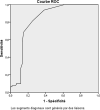Validation of the neutrophil-to-lymphocyte ratio as a new simple biomarker of adult onset Still's disease: A STROBE-Compliant prospective observational study
- PMID: 35960098
- PMCID: PMC9371519
- DOI: 10.1097/MD.0000000000029970
Validation of the neutrophil-to-lymphocyte ratio as a new simple biomarker of adult onset Still's disease: A STROBE-Compliant prospective observational study
Abstract
This study was performed to investigate the role of neutrophil-to-lymphocyte ratio (NLR) in the diagnosis of adult onset Still disease (AOSD) and its performance to improve the sensitivity of the classifications criteria (Yamaguchi and Fautrel Classifications). We conducted a multicenter prospective nationwide case-control study in Internal medicine, Rheumatology and Infectious disease departments, to include successively patients with suspected AOSD (2 or more major criteria of Yamaguchi or Fautrel classifications). All clinical and biological features were collected in a consensual and standardized clinical assessment at baseline and during follow-up. A receiving operating characteristic (ROC) curve was used to reassess the cutoff value of NLR. After determination of the cutoff value for NLR by ROC curve, 2 composite sets (Yamaguchi classification + NLR as a major criterion and Fautrel classification + NLR as a major criterion) were performed and evaluated. One hundred sixty patients were included, 80 patients with AOSD and 60 controls with different diagnoses. Twenty patients with incomplete data were excluded. The cutoff value for NLR equals 4 (area under the curve, AUC: 0.82). The NLR was ≥ 4 in 93.7% (75/80) of AOSD patients with a sensitivity of 93.8% and specificity of 61.7%. The association of NLR as a major criterion with the classification of Yamaguchi or Fautrel improved their sensitivity, respectively for Fautrel (76.3% to 92.5%, P = .004) and Yamaguchi (78.8% to 90%, P = .05). This study validates the NLR as a good simple biomarker of AOSD with a cutoff value of 4 and high sensitivity (93.8%). The addition of NLR (NLR ≥ 4) as a major criterion to the classifications (Yamaguchi and Fautrel) improved significantly their sensitivity and accuracy.
Copyright © 2022 the Author(s). Published by Wolters Kluwer Health, Inc.
Conflict of interest statement
The authors have no funding and conflicts of interest to disclose.
Figures

Similar articles
-
Proposal of a new diagnostic algorithm for adult-onset Still's disease.Clin Rheumatol. 2023 Apr;42(4):1125-1135. doi: 10.1007/s10067-023-06509-8. Epub 2023 Jan 25. Clin Rheumatol. 2023. PMID: 36694091
-
The neutrophil-to-lymphocyte ratio could be a good diagnostic marker and predictor of relapse in patients with adult-onset Still's disease: A STROBE-compliant retrospective observational analysis.Medicine (Baltimore). 2017 Jul;96(29):e7546. doi: 10.1097/MD.0000000000007546. Medicine (Baltimore). 2017. PMID: 28723775 Free PMC article.
-
Validation of the Fautrel classification criteria for adult-onset Still's disease.Semin Arthritis Rheum. 2018 Feb;47(4):578-585. doi: 10.1016/j.semarthrit.2017.07.005. Epub 2017 Jul 12. Semin Arthritis Rheum. 2018. PMID: 28760536
-
Molecular genetic analysis for periodic fever syndromes: a supplemental role for the diagnosis of adult-onset Still's disease.Clin Rheumatol. 2018 Aug;37(8):2021-2026. doi: 10.1007/s10067-018-4178-z. Epub 2018 Jun 17. Clin Rheumatol. 2018. PMID: 29909561 Review.
-
Parenchymal lung involvement in adult-onset Still disease: A STROBE-compliant case series and literature review.Medicine (Baltimore). 2016 Jul;95(30):e4258. doi: 10.1097/MD.0000000000004258. Medicine (Baltimore). 2016. PMID: 27472698 Free PMC article. Review.
Cited by
-
The Independent Value of Neutrophil to Lymphocyte Ratio in Gouty Arthritis: A Narrative Review.J Inflamm Res. 2023 Oct 16;16:4593-4601. doi: 10.2147/JIR.S430831. eCollection 2023. J Inflamm Res. 2023. PMID: 37868831 Free PMC article. Review.
-
The Risk Factors of Refractory Adult-Onset Still's Disease.Int J Hepatol. 2025 Mar 17;2025:6689086. doi: 10.1155/ijh/6689086. eCollection 2025. Int J Hepatol. 2025. PMID: 40134799 Free PMC article.
-
Role of Hematological Indices as Predictors of Systemic Inflammation in Dermatology.Indian Dermatol Online J. 2023 Nov 24;15(2):188-195. doi: 10.4103/idoj.idoj_189_23. eCollection 2024 Mar-Apr. Indian Dermatol Online J. 2023. PMID: 38550825 Free PMC article. Review.
-
B cell subsets in adult-onset Still's disease: potential candidates for disease pathogenesis and immunophenotyping.Arthritis Res Ther. 2023 Jun 15;25(1):104. doi: 10.1186/s13075-023-03070-2. Arthritis Res Ther. 2023. PMID: 37322557 Free PMC article.
-
Adult-Onset Still's Disease (AOSD): Advances in Understanding Pathophysiology, Genetics and Emerging Treatment Options.Drugs. 2024 Mar;84(3):257-274. doi: 10.1007/s40265-024-01993-x. Epub 2024 Mar 5. Drugs. 2024. PMID: 38441807 Free PMC article. Review.
References
-
- Mitrovic S, Fautrel B. New markers for adult-onset Still’s disease. Joint Bone Spine. 2018;85:285–93. - PubMed
-
- Pouchot J, Sampalis JS, Beaudet F, et al. . Adult Still’s disease: manifestations, disease course, and outcome in 62 patients. Medicine (Baltim). 1991;70:118–36. - PubMed
-
- Maria T, Alain Le Q, Christian J, et al. . Adult onset Still’s disease (AOSD) in the era of biologic therapies: dichotomous view for cytokine and clinical expressions. Autoimmun Rev. 2014;13:1149–59. - PubMed
-
- Criado PR, Carvalho JF, Ayabe LA, et al. . Urticaria and dermographism in patients with adult-onset Still’s disease. Rheumatol Int. 2012;32:2551–5. - PubMed
-
- Lee J JY, Hsu CK, Liu MF, et al. . Evanescent and persistent pruritic eruptions of adult-onset Still disease: a clinical and pathologic study of 36 patients. Semin Arthritis Rheum. 2012;42:317–26. - PubMed
Publication types
MeSH terms
Substances
LinkOut - more resources
Full Text Sources

